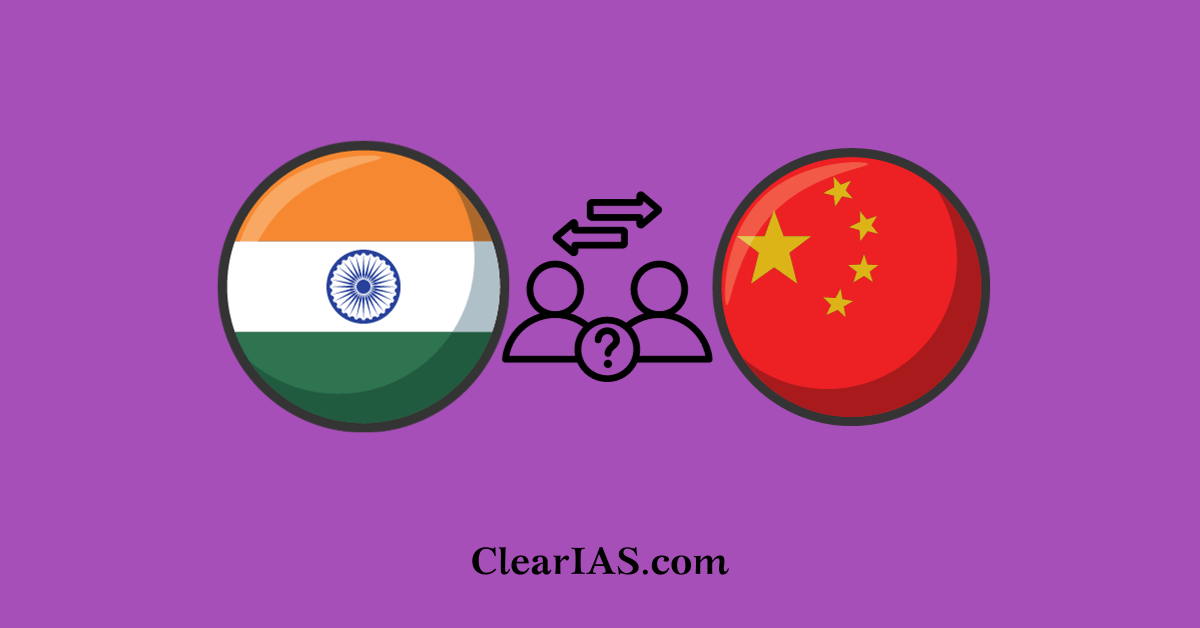
India-China relations are complex, oscillating between strategic rivalry and deep economic interdependence. Despite growing geopolitical tensions, bilateral trade between the two countries has surged over the past two decades, making China one of India’s largest trading partners. However, this trade relationship is marked by structural imbalances, strategic vulnerabilities, and growing calls for diversification and self-reliance. Read here to learn more about the latest developments in India-China Relations.
India-China relations are seeing a slow revival amid unresolved tensions in recent months.
India’s recent decision to resume issuing tourist visas to Chinese nationals and the reopening of the Kailash Mansarovar Yatra are key indicators of a thaw in bilateral ties after years of friction triggered by the Line of Actual Control (LAC) standoff and the Galwan clash in 2020.
However, this resumption of diplomacy masks deeper strategic concerns and unresolved tensions.
India-China relations: latest background
The Galwan Valley clash in June 2020 marked a turning point in India-China relations, with the first fatalities along the border in 45 years.
- The incident severely eroded mutual trust and led to heightened military deployment across the LAC.
- In response, India froze much of its diplomatic and people-to-people engagement with China, while also restricting Chinese investment and imports in sensitive sectors.
Since the meeting between Prime Minister Narendra Modi and Chinese President Xi Jinping in Kazan in 2024, however, diplomatic engagements have increased.
- The Working Mechanism for Consultation and Coordination on India-China Border Affairs (WMCC) has convened three times, and both countries have expressed interest in resuming direct flights, journalist exchanges, and trade discussions.
- India’s participation in upcoming multilateral forums such as the Shanghai Cooperation Organisation (SCO) summit, along with China’s willingness to engage in economic talks, suggests a gradual shift toward normalization.
Areas of Progress
- Resumption of People-to-People Contact: The reopening of tourist visas and pilgrimage routes, including Kailash Mansarovar, indicates a softening of restrictions and a willingness to resume civil exchanges.
- High-Level Dialogues: Multiple WMCC meetings and preparations for the Special Representatives’ meeting on boundary issues suggest that official dialogue is back on track.
- Functional Cooperation: There is a growing understanding to compartmentalize the relationship—engaging on trade and connectivity while discussing boundary issues separately. This is evident in discussions on lifting investment restrictions and resolving supply chain disruptions, especially in the tech and automotive sectors.
- Geopolitical Coordination: The revival of talks coincides with India’s growing participation in regional platforms like SCO, where China plays a leading role. Both countries have shown maturity in managing multilateral cooperation even amid bilateral tensions.
Current Status of India–China Trade
- Trade Volume: India-China bilateral trade reached $136.26 billion in FY 2023–24, slightly down from $138 billion in FY 2022–23.
- Trade Deficit: India’s trade deficit with China stood at over $101 billion in 2023–24, making China the single largest contributor to India’s merchandise trade deficit.
- Top Imports from China:
- Electrical machinery and equipment
- Electronics and components
- Pharmaceuticals (active pharmaceutical ingredients – APIs)
- Chemicals and plastics
- Machinery and mechanical appliances
- Top Indian Exports to China:
- Iron ore
- Cotton and yarn
- Organic chemicals
- Petroleum products
- Agricultural commodities
Why the Trade Deficit Persists
- Value-Chain Dependence: India imports capital goods, electronic components, and APIs crucial for its manufacturing and healthcare sectors.
- Limited Market Access in China: Indian services and pharma companies face regulatory hurdles in accessing Chinese markets.
- Low Value of Exports: India’s export basket to China is dominated by raw materials and low-value goods.
- Limited Tech Capacity: India’s domestic tech manufacturing ecosystem is still evolving, leading to reliance on Chinese components.
India-China trade relations: Strategic Rebalancing
- Leveraging Multilateral Platforms:
- Export Diversification:
- India can increase exports of software services, pharmaceuticals, and renewable technology to China and other markets.
- Push for greater access to the Chinese market, especially in generic drugs and services.
- Strengthening Domestic Manufacturing:
- PLI schemes, semiconductor missions, and IndiaStack (UPI, Aadhaar, DigiLocker) provide a strong base to develop local alternatives.
- Boosting MSMEs with credit, skilling, and digital access will enhance competitiveness.
- Digital Economy and Standards:
- Setting national standards in AI, 5G, and digital trade will help India reduce technological dependence.
Persistent challenges in India-China Relations
Despite these signs of revival, fundamental issues that led to the breakdown of relations remain unaddressed:
- No Clarity on PLA Aggression: China has not explained the 2020 transgressions across the LAC, raising concerns about future unpredictability.
- Partial Disengagement: While some buffer zones have been created, patrolling rights and troop withdrawals remain unresolved in several areas.
- Infrastructure Build-Up: China continues to enhance its military infrastructure along the border, further complicating de-escalation.
- Operation Sindoor Revelations: Reports suggesting coordinated military actions between China and Pakistan during India’s Operation Sindoor add to India’s strategic anxiety and highlight the risk of a two-front threat.
- Economic Dependencies: India continues to depend heavily on Chinese imports, particularly in critical sectors such as pharmaceuticals, electronics, and renewable energy, despite calls for self-reliance.
The Diplomatic Dilemma
India faces a classic dilemma: how to balance the normalization of diplomatic and economic relations without undermining its core security concerns.
- The government had previously asserted that full normalization would only follow the restoration of peace and tranquillity at the border.
- However, recent moves suggest a shift toward a dual-track approach: engaging with China on functional issues while managing unresolved boundary disputes.
- While such compartmentalization may be strategically expedient in the short term, it risks signalling acceptance of the post-2020 status quo.
- If India engages without securing clear commitments on troop disengagement and restoration of patrolling rights, it may inadvertently weaken its negotiating position.
Way forward
The heart of the issues in India-China relations lies in a deep trust deficit. Even as bilateral mechanisms are being revived, the underlying mistrust remains.
Without transparency on past actions and credible guarantees for the future, mere diplomatic contact will not suffice to rebuild confidence.
- India must remain firm in its demand for complete disengagement and restoration of the status quo ante along the LAC.
- At the same time, it must explore confidence-building measures that can reduce friction and prevent accidental escalation.
- These could include hotline mechanisms, joint patrols in disputed areas, and regular military exchanges.
- Simultaneously, India must diversify its economic dependencies and build domestic capabilities in strategic sectors to reduce its vulnerability to external pressure.
- Multilateral diplomacy, such as in the Quad, BRICS, and SCO, should also be leveraged to articulate concerns and shape norms on border behavior and transnational cooperation.
Conclusion
India-China relations are at a delicate juncture. The recent revival of diplomatic and economic ties is a welcome development, but it cannot come at the cost of ignoring core national interests.
For genuine normalization, peace on the border must be non-negotiable.
While trade has been resilient, India must adopt a calibrated strategy to reduce overdependence, build domestic capabilities, and secure its strategic interests.
As geopolitical tensions persist, the future of India-China trade will depend not only on market dynamics but also on diplomacy, security, and technological sovereignty.
Only when mutual respect, transparency, and adherence to past agreements become central to the engagement process can India and China move toward a stable, cooperative future.
Read:







Leave a Reply